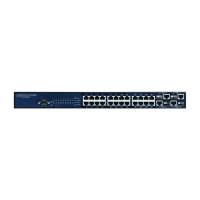C
HAPTER
45
| IP Interface Commands
IPv6 Interface
– 1415 –
EXAMPLE
This example displays all the IPv6 addresses configured for the switch.
Console#show ipv6 interface
VLAN 1 is up
IPv6 is enabled
Link-local address:
FE80::2E0:CFF:FE00:FD/64
Global unicast address(es):
2001:DB8:2222:7273::72/96, subnet is 2001:DB8:2222:7273::/96
Joined group address(es):
FF02::1:FF00:72
FF02::1:FF00:FD
FF02::1
IPv6 link MTU is 1280 bytes
ND DAD is enabled, number of DAD attempts: 3.
ND retransmit interval is 1000 milliseconds
ND advertised retransmit interval is 0 milliseconds
ND reachable time is 30000 milliseconds
ND advertised reachable time is 0 milliseconds
Console#
Table 198: show ipv6 interface - display description
Field Description
VLAN A VLAN is marked “up” if the switch can send and receive packets on this
interface, “down” if a line signal is not present, or “administratively down”
if the interface has been disabled by the administrator.
IPv6 IPv6 is marked “enable” if the switch can send and receive IP traffic on this
interface, “disable” if the switch cannot send and receive IP traffic on this
interface, or “stalled” if a duplicate link-local address is detected on the
interface.
Link-local
address
Shows the link-local address assigned to this interface
Global unicast
address(es)
Shows the global unicast address(es) assigned to this interface
Joined group
address(es)
In addition to the unicast addresses assigned to an interface, a node is
required to join the all-nodes multicast addresses FF01::1 and FF02::1 for
all IPv6 nodes within scope 1 (interface-local) and scope 2 (link-local),
respectively.
FF01::1/16 is the transient interface-local multicast address for all attached
IPv6 nodes, and FF02::1/16 is the link-local multicast address for all
attached IPv6 nodes. The interface-local multicast address is only used for
loopback transmission of multicast traffic. Link-local multicast addresses
cover the same types as used by link-local unicast addresses, including all
nodes (FF02::1), all routers (FF02::2), and solicited nodes
(FF02::1:FFXX:XXXX) as described below.
A node is also required to compute and join the associated solicited-node
multicast addresses for every unicast and anycast address it is assigned.
IPv6 addresses that differ only in the high-order bits, e.g. due to multiple
high-order prefixes associated with different aggregations, will map to the
same solicited-node address, thereby reducing the number of multicast
addresses a node must join. In this example, FF02::1:FF90:0/104 is the
solicited-node multicast address which is formed by taking the low-order 24
bits of the address and appending those bits to the prefix.
ND DAD Indicates whether (neighbor discovery) duplicate address detection is
enabled.
number of DAD
attempts
The number of consecutive neighbor solicitation messages sent on the
interface during duplicate address detection.

